
Adolf was the count of Nassau from about 1276 and the elected king of Germany from 1292 until his deposition by the prince-electors in 1298. He was never crowned by the pope, which would have secured him the imperial title. He was the first physically and mentally healthy ruler of the Holy Roman Empire ever to be deposed without a papal excommunication. Adolf died shortly afterwards in the Battle of Göllheim fighting against his successor Albert of Habsburg.

The Grand Duke of Luxembourg is the head of state of Luxembourg. Luxembourg has been a grand duchy since 15 March 1815, when it was created from territory of the former Duchy of Luxembourg. It was in personal union with the United Kingdom of the Netherlands until 1890 under the House of Orange-Nassau. Luxembourg is the world's only sovereign Grand Duchy and since 1815, there have been nine monarchs, including the incumbent, Henri.

Katzenelnbogen is the name of a castle and small town in the district of Rhein-Lahn-Kreis in Rhineland-Palatinate, Germany. Katzenelnbogen is the seat of the Verbandsgemeinde Aar-Einrich.

William I of Nassau-Siegen, nicknamed the Elder or the Rich, was Count of Nassau-Siegen and half of Diez from 1516 to 1559. He was a descendant of the Ottonian Line of the House of Nassau.
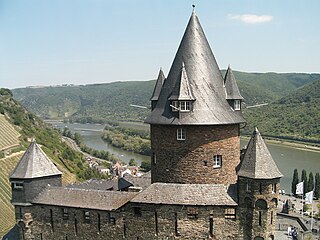
Stahleck Castle is a 12th-century fortified castle in the Upper Middle Rhine Valley at Bacharach in Rhineland-Palatinate, Germany. It stands on a crag approximately 160 metres (520 ft) above sea level on the left bank of the river at the mouth of the Steeg valley, approximately 50 kilometres (31 mi) south of Koblenz, and offers a commanding view of the Lorelei valley. Its name means "impregnable castle on a crag", from the Middle High German words stahel (steel) and ecke. It has a water-filled partial moat, a rarity in Germany. Built on the orders of the Archbishop of Cologne, it was destroyed in the late 17th century but rebuilt in the 20th and is now a hostel.

The Rhine Gorge is a popular name for the Upper Middle Rhine Valley, a 65 km (40 mi) section of the Rhine between Koblenz and Rüdesheim in the states of Rhineland-Palatinate and Hesse in Germany. It was added to the UNESCO list of World Heritage Sites in June 2002 because of its beauty as a cultural landscape, its importance as a route of transport across Europe, and the unique adaptations of the buildings and terraces to the steep slopes of the gorge.
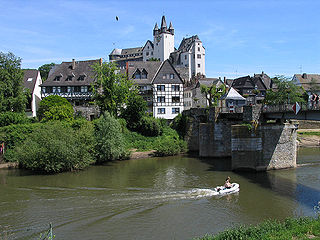
Diez an der Lahn is a town in Germany's Rhein-Lahn district in Rhineland-Palatinate, on the borders of Hesse. Diez is the administrative seat of the municipality of Diez.

Lahnstein is a verband-free town of Rhein-Lahn-Kreis in Rhineland-Palatinate, Germany. It is situated at the confluence of the Lahn with the Rhine, approximately 6 kilometres (3.7 mi) south of Koblenz. Lahnstein was created in 1969 by the merger of the previously independent towns of Oberlahnstein on the south side of the Lahn and Niederlahnstein on the north side. In 2020, it had a population of 18,030.

Middle Rhine is the section of the Rhine between Bingen and Bonn in Germany. It flows through the Rhine Gorge, a formation created by erosion, which happened at about the same rate as an uplift in the region, leaving the river at about its original level, and the surrounding lands raised. This gorge is quite deep, about 130 metres (430 ft) from the top of the rocks down to the average water-line.

Braubach is a municipality in the Rhein-Lahn-Kreis, in Rhineland-Palatinate, Germany. It is situated on the right bank of the Rhine, approx. 10 km southeast of Koblenz. Braubach has assorted medieval architecture intact, including portions of the town wall, half-timbered buildings, and castle Marksburg on the hill above.

Pfalzgrafenstein Castle is a toll castle situated on Falkenau island in the Rhine River, adjacent to Kaub, Germany. Also known as "the Pfalz", Pfalzgrafenstein Castle has never been destroyed since being established in 1326/27.
The Lords of Eppstein were a family of German nobility in the Middle Ages. From the 12th century they ruled extensive territories in the Rhine Main area from their castle in Eppstein, northwest of Frankfurt, Germany.
The Königssondergau was a Frankish gau (district) which existed in the area north of the confluence of the Rhine and Main rivers in Germany, from Frankish times until the end of the 12th century. Often mistakenly equated with the Rheingau, the Gau was based around the former Roman administrative district of Civitas Mattiacorum. The name Kunigessuntera is documented the first time in 819. A main court (fiscus) with senior officials were present in Wiesbaden; sub-courts existed in Biebrich and Mosbach.

The County of Katzenelnbogen was an immediate state of the Holy Roman Empire. It existed between 1095 and 1479, when it was inherited by the Landgraves of Hesse.
Walram I of Nassau, German: Walram I. von Nassau, also known as Walram I of Laurenburg, was Count of Nassau and is the oldest Nassau whose ancestorship is absolutely certain. He managed to expand his territory considerably during his reign. He took part in the Third Crusade.

Count John V of Nassau-Siegen, German: Johann V. Graf von Nassau-Siegen, official titles: Graf zu Nassau, Vianden und Diez, Herr zu Breda, was since 1475 Count of Nassau-Siegen and of half Diez. He descended from the Ottonian Line of the House of Nassau.
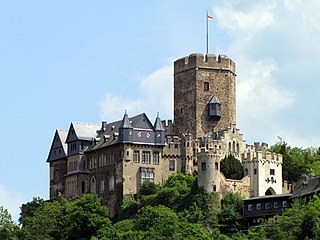
Lahneck Castle is a medieval fortress located in the city of Lahnstein in Rhineland-Palatinate, Germany, south of Koblenz. The 13th-century castle stands on a steep rock salient above the confluence of the Lahn River with the Rhine, opposite Stolzenfels Castle, in the district of Oberlahnstein. Its symmetrical plan, an oblong rectangle, is typical of the later castles of the time of the Hohenstaufen. The pentagonal shape of the bergfried is rare for castle towers.
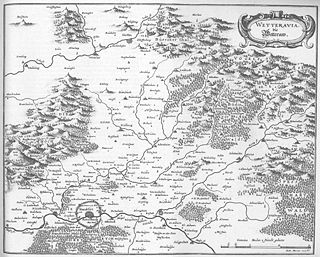
Wetterau Association of Imperial Counts was an association of comital families in the Wetterau and surrounding areas. It originated in the late Middle Ages and was formally disbanded when the Holy Roman Empire was dissolved in 1806.

Landgravine Elisabeth of Hesse-Marburg, German: Elisabeth Landgräfin von Hessen-Marburg, was a landgravine from the House of Hesse-Marburg and through marriage Countess of Nassau-Siegen. She was heiress to the County of Katzenelnbogen, which after her brother's death was claimed both by her and the Landgraviate of Hesse. The legal dispute for the County of Katzenelnbogen between the House of Nassau and the House of Hesse lasted until well after her death and is known as the Katzenelnbogische Erbfolgestreit.
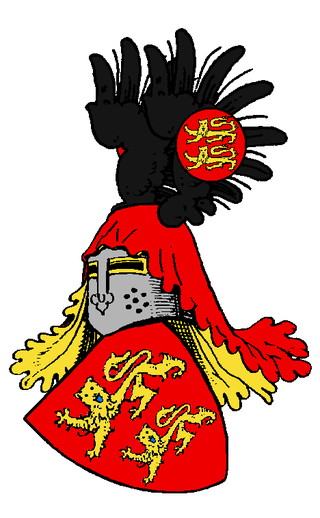
The County of Diez was a county of the Holy Roman Empire, centred around Grafenschloss in Diez, located in Lahngau. The county is first recorded in 1073, likely formed from the lands of the Conradine dynasty after their relocation to Swabia. The Counts of Diez gained prominence in the late twelfth century as strong supporters of the Hohenstaufen dynasty, earning it the nickname "Golden County."




















